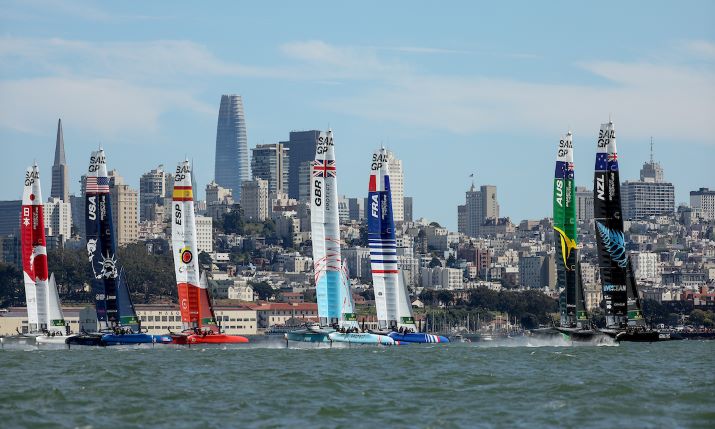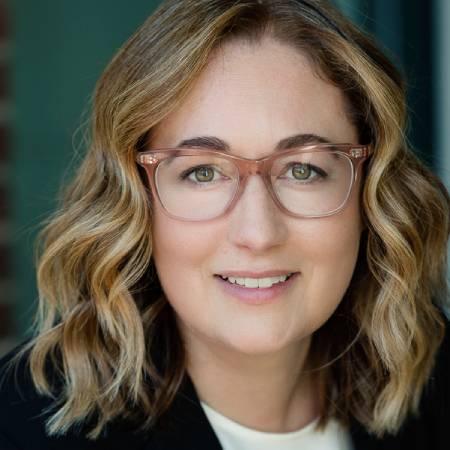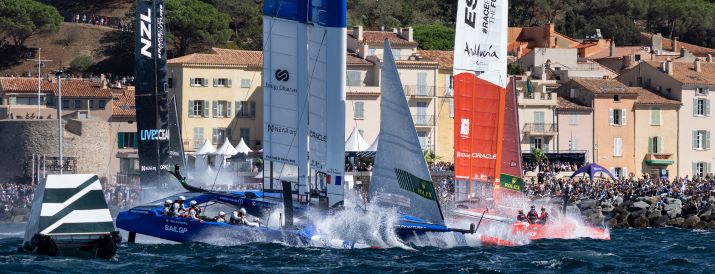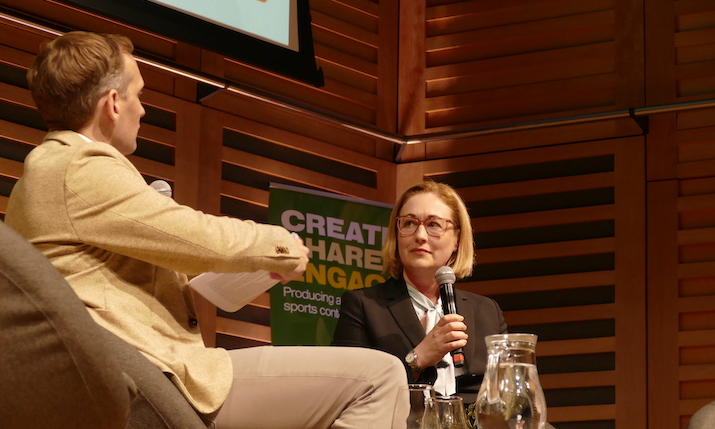Following the circus: Melissa Lawton on her career from the Olympics and Meta to SailGP

SailGP’s season two finale happened in San Francisco on 26 to 27 March
Melissa Lawton, SailGP’s chief content officer, has enjoyed an intense career in which she has forged a path following the routes less travelled by women in sports broadcasting. As an Australian native, she left home in order to pursue her career, which includes working on several Olympic productions and running the live sports production at Meta, and is now a part of a cutting edge grand prix racing championship that is surging into the future.
On how she first got into TV broadcasting and then sports broadcasting as a career, Lawton says: “I had the opportunity to do a lot of work experience when I was in high school and was lucky to work in TV news rooms where I did the odd small story, went out with crews, or worked with the editors in the edit suite. So, I knew of TV broadcasting as a career from an early age, but that wasn’t my ultimate goal at the time. I’d had my dreams set on being a foreign correspondent, but mainly through written news which I loved reading and writing at the time.
“I guess my first real inspiration to get into TV broadcasting was when I had my first full time job in the industry working on the Sydney Olympics in 2000 for the host broadcast, SOBO. It was that experience where I went from being a diehard print journalist, to a TV convert.”
After a degree in journalism at the Royal Melbourne Institute of Technology, Lawton’s first job was writing sports for The Age newspaper as a roving stringer specialising in the Atlanta Olympics in 1996. She comments: “I took a year off after university to continue writing for The Age and the Australian Associated Press, and it ended up taking me on a global tour to various lead up regattas.

SailGP’s Melissa Lawton
“When I got back to Australia after this huge period away, I was approached by someone in the industry to undergo a print journalism cadetship with a country newspaper, and in the same week I received the opportunity of a lifetime to move to Sydney and work on the Sydney Olympic broadcasting organisations workforce,” she continues. “The opportunity came through a work experience contact who I’d worked closely with years before. My career path has always been a strategic one and I was happy that my hard work left a lasting impression to be put forward for such a unique experience. I was prepared and ready to take it. I am a huge fan of the Olympic Movement and I think at that point there was no contest in which path I would end up taking.”
So, she was the manager of sports programming for the Sydney Olympics, a role that began nearly four years prior to the Games themselves. She says: “It had a massive scope for me to learn and grow from some of the best in the business such as Gary Fenton, Manolo Romero, Caroline Ramsay and Mike Klatt. Also, with such a long time before the Games, I got to do a lot of producing on projects like the Olympic opening titles and technical features.”
She continues: “I wasn’t quite ready to give up my other career path so in my spare time I wrote for Time Life magazine’s Olympic programmes to keep my hand in the game. I got to learn and do many things within the Olympic movement and I could see I was becoming more passionate about sports broadcasting than I was about being a print journalist.”
On the detour that gradually led her away from print journalism, she notes: “I think if you’re a print journalist, perhaps you have quite a lonely journey, but when you’re part of a sports broadcasting unit, you’re part of a really big team that can achieve something. I spent my high school years in a rowing crew and really for someone who loved that sort of team sport, production is a perfect fit. You can only be as good as the weakest person in the team, so it’s on everyone to grow and develop and get the best out of the entire crew.”
Following the circus
After the Sydney Olympics, Lawton continued working on the major events circuit, from the Paralympics to the World Cup in Korea and Japan, and more. However, in a bid to break out of being a permanent freelancer doing the same roles over and over again, she broke into network television to work on V8 Supercars, taking a more junior role on major events, “but I was aware I needed to learn the industry from the ground up to have a meaningful career”, she says.
“It was the right opportunity and thing for me to do,” she continues. “I spent three and a half years at Network 10 and loved it. Again I worked with really passionate and talented people who were generous in leading me forward.”
“Then the Beijing Olympics came around. While working on motorsports I decided to do my MA in International Relations and focussed that on the business of sports in China. Honestly, this was another opportunity I couldn’t miss and I got to work with some close colleagues from the Sydney Olympics. I rejoined the Olympic movement, but by then I’d made that step upwards and I was able to use the knowledge I gained from domestic broadcasting to increase my role there.
“After that, I went from the Beijing Olympics to being a coordinating producer of the Delhi Commonwealth Games, as I found myself in India for an opportunity that my husband decided to take for his career. After an adventure-filled 2.5 years living and working in India, we returned to Australia with our baby and no real direction on where to go next in the sports industry.”
However, she says, “fortune favours the brave I guess, and not long after the birth of my second child I was approached by Salzburg Austria to take an unmissable opportunity to work for Red Bull Media House as head of live content (not just sports). After five years, gaining a load of digital experience under my belt, I was offered something I could not say no to – running the live sports production project for Meta in New York – that was both massive and ambitious in its scope.”
 Growing SailGP
Growing SailGP
Now, as chief content officer at SailGP, Lawton has a wide remit that brings all her skills into play. SailGP identified the job as a critical role to grow the league, and created it then found Lawton to fill it.
On why she went for it, Lawton says: “SailGP represented so many things that were very appealing to me. Firstly it’s a league that is disruptive, heavily reliant on cutting edge technology, and was in a building and growth phase having survived COVID disruptions during its second season. Additionally, it was a company with a clear purpose, one that would make me feel good about going to work as the backbone of SailGP is to race for the future, for a better sport and a better planet.
“When I met the interview panel including CEO Russell Coutts, he really doubled down on the idea that they were building a sports entertainment product that was heavily reliant on content. I really felt like it was going to be the right level of challenging, satisfying, and quite frankly, would give me the autonomy to create a strategy to move the company forward. It was a rare opportunity and I could see that.”
She adds: “The idea of the broadcast being remote was significant, as a mother of tweens I didn’t want to revert back to flying to different destinations and missing important occasions. It seemed absolutely ideal from that perspective.”
The remote production side of SailGP was a big draw of the job for Lawton, who elaborates: “Firstly, as a working mum, I can do six North American events a year and still watch my kids play sports, or go out to lunch with friends before I need to go into work for that evening’s coverage. So that was a key factor in me taking this role; the idea that I could still be heavily involved in the broadcast, I could still sit in the gallery, but not actually have to get on a plane and fly somewhere to do it and miss those moments in my family’s life.”
On how remote production can help increase the diversity of a sports broadcasting crew, she adds: “From a diversity perspective, I think remote production is important but I don’t know that we’ve cracked the nut yet. I’m still not seeing a lot of young women come up. Maybe the [remote production] system’s too new and perhaps when you’re younger, you want to do that travelling before you have a family. But the other side is socio-economic diversity. There are some people who, to leave their families behind for a week, just wouldn’t work for their wider life. So perhaps being able to just go into work in one location and still work on significant global events is better for their lives. I think life stress is also reduced when you are not travelling.
“But I think I do have this sense that as more companies adopt remote production workflows, there will be a greater number of people who will stay longer in the industry, and not be forced out because they have kids in high school or elementary school and they are unable to get the right childcare for them,” she continues.

Melissa Lawton, chief content officer at SailGP, on stage at SVG Europe’s Create, Share, Engage event in London last May
Reimaging the sport
Lawton started working for SailGP while living in the US, but three months down the line realised she could not do it from that location for much longer. She explains: “I needed to get to know the team and their strengths. We had a new season starting, and although we already had a decent broadcast, long form content, and a system in place for socials, the next step was supercharging all of that.
“Particularly, we had to reimagine how we talked about our sport; I think the time spent creating a production philosophy was the most important. We had to sit down and understand “what is this sport?”, “how do I talk about this sport to make it interesting to people who don’t know sailing and don’t understand it at all?”, and “what are the key connecting points we can adapt from other sports that anyone who’s watching this sport would enjoy?”.
“We didn’t want to sell sailing to people who weren’t interested in sailing,” she continues. “We wanted to sell racing to people who loved racing. We had to train the commentators to not use sailing terms, and move away from behind the scenes content – which we focused on in our long form – to more storytelling content that told the story of the league and athletes within it. With social content creation, we had to pivot our strategy into more engaging content that everyone can identify with, rather than just informative content that helps someone understand the sport.
“Currently, our biggest focus is on continuing to develop awareness of this compelling league that we are winning with. We’ve recently entered into or extended a number of broadcast deals with partners found in our network including ITV in the UK, Canal+ in France, and Warner Brothers Discovery in New Zealand to support this goal. On the other hand, producing engaging social and digital content is a difficult logistical operation due to limited resources and access to the boats and the teams, especially as we do not want to increase our carbon footprint to make that content. It’s all a balancing act of prioritising and looking at opportunities.”
Facing challenges
On the biggest challenges of her career, Lawton points to the need to change location on a relatively regular basis, which of course has implications for family life. She explains: “I think the biggest challenge for me was the knowledge that to grow, I had to leave Australia. Sports broadcasting in Australia was basically football or motorsports for the big sports and everything else meant a freelance career. If you wanted to really make a living out of sports broadcasting and get to the top, you had limited pathways. So, leaving Australia was both the hardest but also probably the best thing I did for my career.
“Also, I have a partner whose career has become secondary to mine especially as my opportunities keep taking us to foreign locations. I don’t just move to a new role; we move to a new country, and add kids into that equation and life can hit peak stress at times,” she warns.
“It hasn’t always been easy for my husband to arrive in a new location and then figure out what he wants to do,” Lawton continues. “And that’s sometimes been a negotiation on what opportunities we entertain. Now that I have kids heading into high school, schooling priorities become higher on the agenda. There is no dropping everything to go to the next location because it suits me; it has to be a family decision.”
She adds that as a woman, her chosen career path has sometimes been difficult to keep on track. She says: “Being a female and wanting to work on the production side of such a male-dominated industry sometimes felt like I was swimming against the tide. If you want to work in sports production, it’s hard to push against the tide and many talented women are funnelled into sports production management, PR, communications or marketing, and given little opportunity to move sideways or up. I was determined to stay in sports broadcasting as a producer, an editorial decision maker, and a content strategist and to do that, I often had to really take an alternative path to reach the next level, go to companies that were disrupting the status quo and thinking about the industry in a different way.”
Lawton’s advice to anyone else looking to forge a career in sports broadcasting is this: “I think you need a basic knowledge of the technical set up that underpins different areas, whether it’s the backend of a social app, understanding how live production happens, to set up edit, and tools that help you get your work done. You don’t need to love that, you just need to have a good understanding so that as you get a role that’s larger in scope, you can focus on things like workflows and scalability that help you do a better job from a return on investment perspective, like reducing budgets and increasing output.
“But on the other hand, like I said before, the idea that women are funnelled into certain areas of production management – if you really want to be on the broadcasting side, and you don’t want to be sitting at a director’s assistant desk long term – you’ve really got to move sideways or look for other opportunities to grow,” she notes. “My favourite motto is ‘knowledge is power’; the more you can understand about the industry and learn about different roles, the more likely you’ll be in the right position at the right time when someone’s looking for that person.”
The future for her at SailGP – and the future of SailGP itself – look very bright to Lawton, and she wants to show other women in this industry that you can be whatever you want to be. “I can really see what the future looks like and how to get there. I think the core products that we produce are the right ones, and it’s about the opportunity to expand and promote those as far as they can go.
“The future looks really bright and I am excited by the pure potential of what we have! I am also excited by my team and colleagues. SailGP has had the ability to attract very, very good people and it’s a pleasure to work with them.”

